
Wood Turning Tools
Sharpening Jig
"We do not sharpen because a wood turning tool is dull, we sharpen because it is not sharp enough."
| Sharpening wood turning tools quickly and consistently is a constant problem for a wood turner. We stand in front of a machine that throws wood at us at about 75 miles an hour and stop it with sharp tools. A typical gouge cuts more wood in a few minutes than a hand plane does in an hour. Also the wood we work with is often straight from a log with bark still on it and sometimes sand and rocks from when it was felled. There may even be imbedded metal where a tree has grown over a nail or spike, not to mention horse shoes and other objects turners have found. A working edge has to be obtained quickly and easily and then back to the work. | |
The carver's razor edge obtained from finer and finer grits of stones followed by a leather strop is not for us. It just does not last. Instead we tend to go from the grinder to the work. Therefore I start with the grinder. My particular sharpening system starts with a typical, mass market tool grinder, 3500 rpm, mounted to a secure stand. My stand has 20 pounds of sand in the bottom to absorb vibration and give stability.
I first replace one of the abrasive wheels with an aluminum oxide, 60 grit, soft bond wheel. In my case the left for no other reason than it first held the included coarse wheel and I wanted to leave on the medium grit. The new wheel can be obtained from most wood turning suppliers. It just gives a cooler grind that is less likely to burn the high speed steel our tools are made from and gives an edge that is plenty sharp for the work we do.
In order to properly sharpen a tool, the grinder wheel must be round and clean. I use a diamond dresser to round the wheel and a star wheel dresser to clean it. While I may clean the wheel fairly often, sometimes daily, I usually round it about every three months. When the wheel looks glazed with steel, clean it and when a tool bounces on the wheel, round it.
I removed the grinding table that came on the grinder and replaced it with a home made sharpening jig. Jigs are great for reproducing a grind time after time. They let you get a consistent edge and bevel and get back to work. While I started by learning to freehand grind, I am better with a jig and use it consistently. Having said that, parting tools, scrapers and skews are easily sharpened by hand because they are straight edges or simple curves.
| Here you can see the grinder on a stand and the jig I have made at the left wheel. There is also a Veritas grinding platform in front of the jig. A gift I received, it is an excellent replacement for the usual inadequate grinding platforms included with the grinders. Hanging from the side are various holders for the gouges or tools. I found it easier to make separate holders for different tools than to make an adjustable holder. It only takes a few minutes to make a holder. |

|
| The jig consists of those holders and a movable arm to pivot the tool. You can see that the arm is adjusted with a bolt in a slot. I keep meaning to change to a thumscrew but this works so well I have never bothered. Set the distance for the tool to protrude from the holder, tighten the eyebolt (cheaper than thumscrews and have a larger gripping surface for your fingers), set the end of the holder rod in the pivot, rock and turn. I have not timed it but I am probably back at the lathe with a sharp tool in less than a minute. | |
| Here you see the 1/2" holder in which the 1/2" refers to the maximum size of shaft it takes. With it are a typically sharpened bowl gouge and Oland tool. |

|
| Here is a 60 degree holder and the typical spindle gouge grind it gives. I did not mark the gouge size on the holder as I seldom use spindle gouges and use this holder for 1/4" to 1/2" spindle gouges. I could do the same for the bowl gouges or Oland tools but prefer to have one for each size shaft as I use the Oland tools a lot and am too lazy to want to keep turning the eye bolt in and out. |

|
| This is a rough sketch I did some time ago for someone who wanted to set up the system. It is kept under the "one of these days I will take the time to do it right" set of ideas. The system is not complicated and the sketch should give enough information to duplicate it. I made it out of scrap plywood and hot glue. One of these days I may improve it, but it works so well that I am hesitant to "fix" it. |
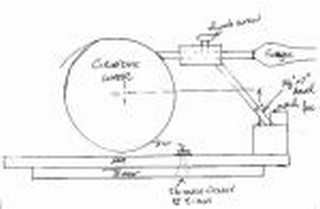
|
To use the jig for a roughing gouge or for a bowl gouge ground straight across:
|
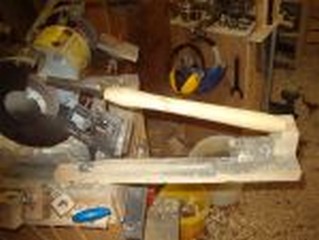
|
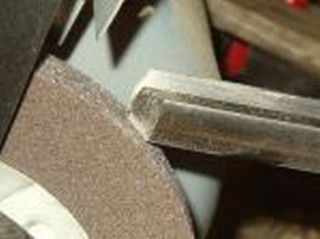
|
|
To use the jig for a spindle gouge:
|
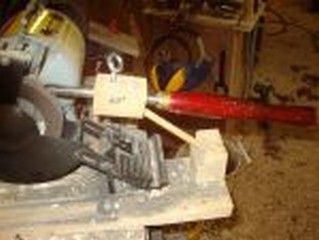
|

|
|
To use the jig for a bowl gouge with drawn back wings:
|
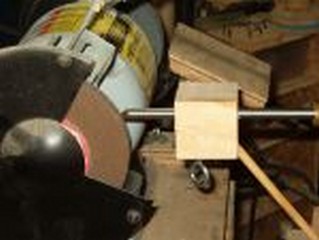
|
To use the jig for an Oland Tool:
|

|
Normally I sharpen a skew by hand but if you are new to sharpening the jig can be used. Note that the long point will have a longer bevel than the short, but this does not hurt the cutting with the skew.
|

|

|
|
In response to some questions about the procedures on this page I rewrote a lote of the material and added some videos and pictures for greater explanation. You can find it at the the new sharpening page.
If you make one please let me know how it turned out.
© 2015 copyright Darrell Feltmate, Around the Woods